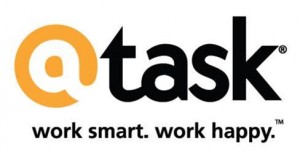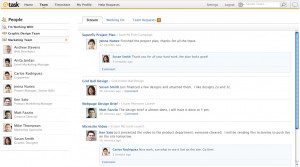This is the second entry in the PM Visionary Series.
I’ve spent well over a year getting to know Ty Kiisel of At Task Software. We’ve spent a lot of time on each other’s blogs, and I’ve been on his Talking Work podcast. Despite the fact that we’ve never met, I’ve come to think of him as a good friend. So it’s my great pleasure to have the opportunity to publish his thoughts on At Task’s vision. In today’s piece, explore his reaction to the Chaos Report, Genyo Takeda’s (Nintendo) influence, and software that gets in the way. Please give Ty a warm welcome to Papercut Edge by leaving your comments on his article below!
What Inspires AtTask
 I don’t often write about AtTask, but I’m writing today for two reasons. First, Geoff’s kind encouragement is hard to resist, and the things that fundamentally inspire our company are core to why I write about leading project teams and managing projects. I also believe AtTask is significantly different from every other project management software on the market today.
I don’t often write about AtTask, but I’m writing today for two reasons. First, Geoff’s kind encouragement is hard to resist, and the things that fundamentally inspire our company are core to why I write about leading project teams and managing projects. I also believe AtTask is significantly different from every other project management software on the market today.
The Chaos Survey and Failing Projects
A few years ago our company came to the realization that project and portfolio management (PPM) software and the way projects were managed was essentially broken. I recognize that some of my colleagues who work in project management questions whether or not the Chaos Survey’s embarrassing project failure statistics are an accurate representation of the state of projects, however they represent a trend that should be a real concern to our profession. I’ve also heard it reported that 50 percent of new Project Management Offices (PMO’s) fail in the first 18 months. Holy cow, by anyone’s measure, these are horrible statistics—even if they aren’t completely accurate.
In my opinion, PPM software should share some of the blame. With the exception of accounting software, PM software has been around the longest—and most of the software feels that way. The dirty little secret of project management software is that it is so difficult for most people to use, nobody does. What’s more, some software, even after a years-long implementation, is unable to provide value to the organizations that were told their software was “best in class PPM software.”
 What Makes the AtTask Vision Unique?
What Makes the AtTask Vision Unique?
AtTask CEO Scott Johnson’s vision has always been to help people better understand and organize their work. You didn’t have to look too hard to see that the current paradigm espoused by PM software companies (including us at the time) didn’t help. Feature rich software failed to provide the value expected. Additionally, it didn’t matter whose software it was—PPM software was broken. Of course, an internal champion could keep things going for a while, but as soon as he or she left to another company or another department, software usage would suffer, project managers would have to resort to manually collecting status again, and business leaders lost whatever visibility they had into projects.
If you’ve been a working project professional for any length of time, this comes as no surprise.
Johnson wanted to help organizations manage work—and realized that business-as-usual wasn’t going to do it. We decided to take a different approach. We started visiting customers and non-customers to sit in their cubes, attend their status meetings, watch them interact with each other, their sticky notes, their white boards, their spreadsheets—and their software.
PPM Software and the Wii
Genyo Takeda, the developer of the Nintendo Wii, describes very well why the conventional wisdom about how PPM software is designed is fundamentally flawed. “This may sound paradoxical, but if we had followed the existing road-maps we would have aimed to make it ‘faster and flashier.’ In other words, we would have tried to improve the speed at which it displays stunning graphics. But we could not help but ask ourselves, ‘How big an impact would that direction really have on our customers?’”
We asked ourselves the same questions. Continuing to add and refine specific and obscure PPM features wasn’t really helping organizations better understand and organize their work.
Takeda continued, “There is no end to the desire of those who just want more. Give them one, they ask for two. Give them two, and the next time they will ask for five instead of three. Then they will want ten, thirty, a hundred, their desire growing exponentially. Giving in to this will lead us nowhere in the end. I started feeling unsure about following this path about a year into development.”
The way Takeda changed video games resonates with me. Most project management software development is driven by feature requests (what end users and developers think they need). It doesn’t help that the people buying the software aren’t always the people using the software. Most of the PPM practices we use today are 50-100 years old and aren’t really effective at helping today’s knowledge worker deal with the creative problem solving that goes on within most project teams.
Of course, contextual inquiry is expensive. It takes hours sitting beside users, watching them interact with the process. The result of not doing this has resulted in unimaginative software that is tedious and cumbersome to use.
So What Did We Really Learn?
For starters, we learned that polling our customers and incorporating feature requests wasn’t really helping them meet their objectives. By watching the process with fresh eyes, we learned that PPM software didn’t work the way people really worked—in fact, it got in the way. We also learned that the most ignored member of the project management process was actually the linchpin to whether or not projects were successful.
 We discovered that the critical person that determined whether or not a project was successful wasn’t the project manager or the sponsor—it was an individual team member. We also recognized that if we could capture project information at the source (the individual contributor), we could achieve a more accurate picture of project status for informing decisions. Business leaders really need more qualitative information than a simple Green, Red or Yellow indicator.
We discovered that the critical person that determined whether or not a project was successful wasn’t the project manager or the sponsor—it was an individual team member. We also recognized that if we could capture project information at the source (the individual contributor), we could achieve a more accurate picture of project status for informing decisions. Business leaders really need more qualitative information than a simple Green, Red or Yellow indicator.
Providing Value—Making Project Management Work
Our conclusions are so obvious now, it seems that everyone is giving lip service to them. As an organization, we believe that those closest to the work understand it best. We also believe that people want to do something meaningful and contribute to something greater than themselves. Today’s workforce wants to be empowered to make those contributions. They also want recognition for what they do by their managers and peers.
To do that, democratizing the process and making project management more “social” just seems to make sense. However, it’s not about incorporating a Twitter or Facebook feed into the software. It’s about creating an environment where people can work they way they naturally work and have meaningful conversations about their work (Twitter-like, but not Twitter).
These conversations provide context to otherwise marginally meaningful status indicators, giving opportunity to peers and managers to provide feedback and give the same kind of recognition people get on other social media.
Democratizing work allows team members to have input into time-lines and deliverables, giving them a sense of ownership. This type of ownership doesn’t exist within a top-down management culture.
And, it requires something more than a simple user interface makeover. Project management software needs to help people work the way they naturally work and collaborate with their peers in a way that makes sense and provides value at the grass-roots level. We need to change the way we think about managing work, which will change the way we build software to do it. We’ve embraced that paradigm-shift, and that’s what makes AtTask different and what is driving our company and our product development. We challenge other project management software providers to do the same. Until they do, our industry will struggle with poor adoption in organizations, failing projects and worse—irrelevance.

Ty Kiisel is a work management evangelist; “accidental” project manager and marketing veteran with over 25 years of experience. He writes about project management, leading teams, and basically getting work done for AtTask, Inc.. Ty’s blog is syndicated daily on Alltop, CIOZone, Gantthead, and IT Toolbox. He also writes a regular tips article for IT World and contributes as one of their Trusted Voices. Ty makes the concepts and best practices of work management accessible to both the expert and novice (or accidental) project professional by weaving personal experiences, historical references and other anecdotes into daily discussions around effective leadership approaches that maximize the effectiveness of teams. His bi-weekly podcast, TalkingWork, introduces successful work management practices to a new audience with an entertaining and informative format including interviews with industry experts and successful business leaders. Ty is a contributor to two books, one to be released later this year, The Project Pain Reliever and the recently published Business Driven PPM.
